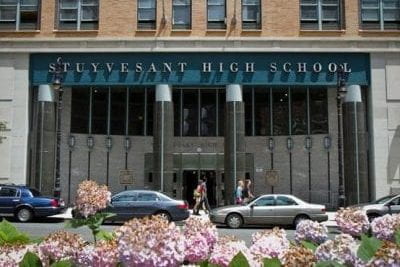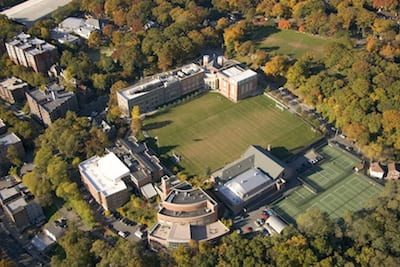Another 4 Years of High School: The Stuyvesant-Horace Mann to UChicago Pipeline
Berenice Martinez, Isabel Reyes, Kevin Song
Disclaimer: This project was completed under pedagogical purposes for an undergraduate sociology course at the University of Chicago. While we are publicly sharing results from our capstone project, it is important readers understand that these are NOT findings from a human subjects research project intended to contribute generalizable knowledge
Introduction
Historical inequities in access, particularly in regard to socioeconomic, racial, and ethnic demographics, plagues higher education institutions in the United States. This study analyzes college admissions processes to the University of Chicago from two elite feeder schools in New York City: Stuyvesant and Horace Mann, a public and private school, respectively. The University of Chicago in their “Non-discrimination Statement”, like schools of similar calibers, prides itself in its initiatives of accessibility, diversity and inclusion for students of diverse identities and backgrounds (University of Chicago “Non-discrimination Statement”). However, considering the University’s unique acceptance statistics of students from Stuyvesant and Horace Mann, these initiatives seem inconsistent with a goal of accessibility, and may further socioeconomic inequities in the school. Taking into account the racial and socioeconomic complexities at these schools, our project aims to study the privileges within the college admissions processes at Stuyvesant and Horace Mann and how these racial and class structures might thus reproduce themselves at UChicago.
STUYVESANT HIGH SCHOOL
New York, NY
HORACE MANN SCHOOL
Bronx, NY


Research Question
How do differences in cultural and social capital generated among students by the institutional environment and resources at Stuyvesant and Horace Mann, respectively, shape the desirability of these schools as “feeders” for UChicago? More specifically, how does school type influence the admissions processes to UChicago at these two schools?
Literature Review
Previous literature shows that feeder networks can contribute to reproducing social inequalities and that elite institutions are shifting away from private feeder networks to more meritocratic practices, such as test scores, or to utilizing public school feeder networks. The individuals that are admitted tend to be from white and affluent backgrounds. According to LeTendre, Gonzalez, & Nomi (2006: 26), feeder high schools contribute to these inequalities by allowing certain students to gain access to elite universities at the expense of other students. Feeder schools have “institutionalized mechanisms of guidance and placement” that allow them to place their students into elite institutions. A feeder school, according to Hong (2010: 3), can be considered those “who send 10 or more students to the University in any given year.” It is important to keep this framework in mind when examining New York’s high school system. Stuyvesant, a specialized, selective public high school, sends significantly more students to UChicago compared to its similar counterparts, e.g., Brooklyn Technical High School (BTHS) (BTHS 2010). This is also present in private schools: Horace Mann, a NYC K-12 prep school, has sent over 93 students to UChicago in the past 5 years, the largest of any school (Horace Mann School “Tuition & Financial Aid”). These findings probe us to look deeper into the relations between these institutions to understand how they work to create this feeder school pipeline.
Methodology
Screening Survey
Interviews
4 Stuyvesant Alumni, 4 Horace Mann Alumni, 1 Stuyvesant College Counselor
Follow-up Survey
Average Household Income, Parental Occupation, Student’s Race/Ethnicity
We conducted 2 rounds of survey research to screen student participants and gather student SES data. We also interviewed UChicago students from Stuyvesant and Horace Mann as well as 1 Stuyvesant college counselor. Interviews provide a more nuanced understanding on individual experiences with feeder networks rather than a purely quantitative analysis. To analyze our data, we engaged in open-coding techniques, highlighting important phrases and grouping them into relevant themes. We utilized Otter.ai to transcribe the data and used Word to code and group our findings.
Findings/Results
MUTUALLY BENEFICIAL RELATIONSHIP
Stuyvesant has many first-generation, low-income students who are academically prepared for UChicago and fulfill its diversity and inclusion initiatives. Horace Mann students are also academically prepared, but are typically wealthy and retain the social and cultural capital characteristic to UChicago’s academic and social environment. These schools develop a mutually beneficial relationship to UChicago: Stuyvesant students fulfill certain diversity quotas in exchange for scholarships, and Horace Mann students are a reliable pool of applicants that can afford to pay UChicago’s tuition and in exchange, they can continue their elite education where they can utilize their cultural capital to ease their transition into college.
SENSE OF SECURITY/FAMILIARITY
Among both Stuyvesant and Horace Mann graduates, students from their respective schools typically found a sense of security regarding their applications to UChicago, as it was widely considered a reliable option considering these school’s unspoken feeder relationships to the university. Students were aware of the their high school’s feeder connection to UChicago and the social, cultural, and academic similarities. They felt they’d have a stronger chance at admission to UChicago over other prestigious schools (such as Ivy League institutions), often using the words “safety” or “back-up” when referring to UChicago.
DIFFERING ATTITUDES TOWARD FEEDER RELATIONSHIP
Our interviews with Horace Mann students revealed a particularly negative attitude that existed within the student body towards the feeder relationship to UChicago. Admission to UChicago was considered a relatively easy cop-out amongst Horace Mann students. This sentiment was not particularly felt by Stuyvesant students; rather, they still viewed admissions to UChicago somewhat competitive and still indicative of their efforts and merit. Admission to UChicago was not downplayed amongst Stuyvesant students.
COLLEGE COUNSELING RESOURCES
Stuyvesant’s student body is almost quadruple that of Horace Mann’s, and we found that the quality of college programming resources significantly differed between the two schools. The average caseload for a Stuyvesant college counselor is around 150 students, compared to 30 for Horace Mann counselors. School-led college visits at Stuyvesant also tended to be oversubscribed and underfunded, usually affording around 50 students to tour select schools in the Northeast. Horace Mann, on the other hand, subsidizes college visits during spring break, where students are allowed to visit any college they want with a college counselor.
Discussion
Feeder networks streamline student from different socioeconomic backgrounds: wealthy students and low-income students, without having to change how inaccessible the institution is to those who do not fall within these feeder networks. Higher educational institutions utilize college admission processes to proliferate social inequalities in access (Karabel 2005; Wolniak & Enberg 2007). This security coupled with the economic and social benefit UChicago gets, maintains the feeder network between these institutions, replicating the microcosms of SES and race, and excluding non-white, non-Asian students from the same admissions opportunities.
Researchers have also argued that feeder schools have institutionalized mechanisms of guidance that propel students to elite colleges ( LeTendre, Gonzalez, & Nomi 2006). Although placements into UChicago are identical, these schools have intergroup differences in guidance. Since Stuyvesant has less college programming resources, students often felt their college office was understaffed and lacked individualized support. This wasn’t felt by Horace Mann students.
Lastly, differences in students’ attitudes towards feeder relationships can be attributed to their socioeconomic statuses. Horace Mann students often come from a privileged SES background due to their educational and familial statuses. These students tend to internalize this feeder advantage as a reflection of their intellect or merit. Whereas Stuy students generally have more individual responsibility to their academic and college application performances, and seemed less likely to view the feeder relationship as a reflection of their merit.
Conclusion
Our data was limited by a variety of factors. Due to pressures of facing institutional liability, UChicago college admission officers and Horace Mann counselors refused to partake in our study, restricting our findings. Additionally, due to limited scope of data collection (e.g. social media), our interviewees were not racially diverse, only providing us insight into white and Asian experiences at these schools. We were also unable to obtain survey SES data from all participants due to participant error. Further research should explore how these feeder networks function across an array of racial and backgrounds and how this may be impacted by school type.
Although our data was limited, our findings show that feeder networks like Stuyvesant and Horace Mann create a mutually beneficial relationship between UChicago and their students. Stuyvesant is able to supply students from low socioeconomic status, which can help further UChicago’s diversity and inclusion initiatives. Horace Mann can allow UChicago students to secure a pool of wealthy students that may be eligible to pay tuition. These feeder networks, however, disproportionately favor groups of students above others, which contributes to making these elite institutions inaccessible to students who do not reside within these feeder networks — most notably non-White and non-Asian students, who represent the racial majority of these two schools. Therefore, UChicago’s “Non-Discrimination” statement is inconsistent with our findings, as having feeder networks to two elite NYC schools proliferates social inequalities, rather than making higher education accessible to disadvantaged populations.
WORKS CITED
Andersen, P. L., and M. N. Hansen. “Class and Cultural Capital–The Case of Class Inequality in Educational Performance.” European Sociological Review 28, no. 5 (2012): 607–21. https://doi.org/10.1093/esr/jcr029.
Borooah, Vani K., Donal Dineen, and Nicola Lynch. “Which Are the ‘Best’ Feeder Schools in Ireland? Analyzing School Performance Using Student Third Level Destination Data.” Irish Educational Studies 29, no. 2 (2010): 107–30. https://doi.org/10.1080/03323311003779027.
BTHS. “BTHS College Acceptance Results,” Brooklyn Technical High School (BTHS), 2010. http://bths.edu/ourpages/auto/2010/11/16/50058930/2010_Data.pdf
Engberg, Mark E., and Gregory C. Wolniak. “Examining the Effects of High School Contexts on Postsecondary Enrollment.” Research in Higher Education 51, no. 2 (2009): 132–53. https://doi.org/10.1007/s11162-009-9150-y.
Hong, Nicole. “Making the Class.” The Daily Northwestern, May 12, 2010. https://dailynorthwestern.com/2010/05/12/archive-manual/making-the-class/.
Horace Mann School, The College Admissions Process at Horace Mann 2013-2017. PDF file. https://www.horacemann.org/uploaded/HoraceMann/Admissions/2017_College_attended_List.pdf.
Horace Mann School. “Tuition & Financial Aid.” Accessed October 18, 2020. https://www.horacemann.org/admissions/tuition-financial-aid.
Karabel, Jerome. “Status-Group Struggle, Organizational Interests, and the Limits of Institutional Autonomy.” Theory and Society 13, no. 1 (1984): 1–40. https://doi.org/10.1007/bf00159255.
Karabel, Jerome. The Chosen: The Hidden History of Admission and Exclusion at Harvard, Yale, and Princeton. Boston: A Mariner Book Houghton Mifflin Company, 2005.
LeTendre, Gerald K, Roger Geertz Gonzalez, and Takako Nomi. “Feeding the Elite: The Evolution of Elite Pathways from Star High Schools to Elite Universities.” Higher Education Policy 19, no. 1 (2006): 7–30. https://doi.org/10.1057/palgrave.hep.8300108.
McDonough, Patricia. Choosing Colleges: How Social Class and Schools Structure Opportunity. NY: SUNY Press, 1997.
Niche.“2021 Best Private High Schools in New York.” Accessed October 18, 2020. https://www.niche.com/k12/search/best-private-high-schools/s/new-york/.
NYSED. “2018: NY STATE – Enrollment Data: NYSED Data Site.” Accessed October 18, 2020. https://data.nysed.gov/enrollment.php?year=2018.
SHSAT. “SHSAT Frequently Asked Questions (FAQ)” Accessed November 29, 2020. https://shsat.org/faq/
Stuber, Jenny M. “Class, Culture, and Participation in the Collegiate Extra-Curriculum.” Sociological Forum 24, no. 4 (2009): 877–900. https://doi.org/10.1111/j.1573-7861.2009.01140.x.
“These Are the Best High Schools in New York.” U.S. News & World Report. U.S. News & World Report. Accessed October 18, 2020. https://www.usnews.com/education/best-high-schools/new-york/rankings.
The University of Chicago. “Admissions & Aid.” Accessed October 18, 2020. https://www.uchicago.edu/admissions/.
The University of Chicago. “Non-Discrimination Statement.” Accessed October 18, 2020. https://www.uchicago.edu/about/non_discrimination_statement/.
The University of Chicago. “The Admissions Office” Accessed October 18, 2020. https://collegeadmissions.uchicago.edu/contact.
Tough, Paul. “What College Admissions Offices Really Want.” The New York Times. The New York Times, September 10, 2019. https://www.nytimes.com/interactive/2019/09/10/magazine/college-admissions-paul-tough.html?mtrref=undefined.
USASchoolInfo.com. “Horace Mann School Bronx, NY Enrollment & Demographics.” USASchoolInfo. Accessed October 18, 2020. http://www.usaschoolinfo.com/school/horace-mann-school-bronx-new-york.113787/enrollment.
Wechsler, Harold S. The Qualified Student A History of Selective College Admission in America. Taylor & Francis Ltd, 1977.
Wolniak, Gregory C., and Mark E. Engberg. “The Effects of High School Feeder Networks on College Enrollment.” The Review of Higher Education 31, no. 1 (2007): 27–53. https://doi.org/10.1353/rhe.2007.0054.
